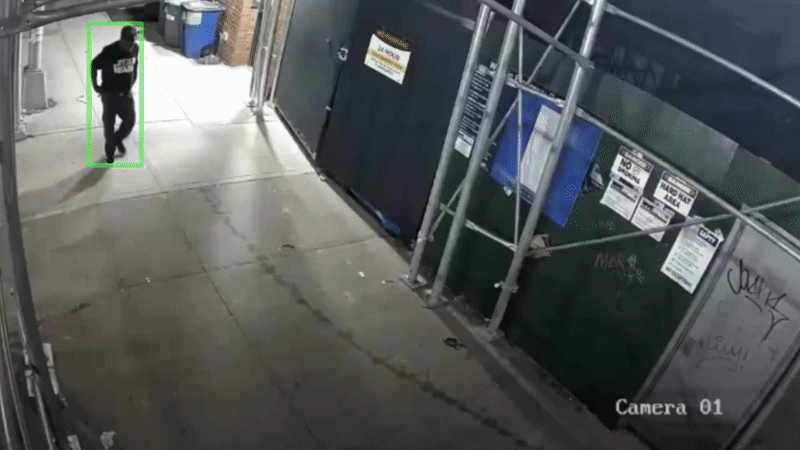Strong perimeter security is the first line of defense against unauthorized access to people, property, and critical infrastructure. When it comes to detecting, deterring, and delaying intruders, fortifying perimeter security within your physical security program is of paramount importance.
In this article, we’ll dive into everything you must know to fortify your perimeter security: the different types of perimeter security systems, common challenges, how AI enables success, and more.
To get perimeter security insights and best practices straight from security experts at Blue Origin & Robinhood, check out our on-demand webinar.
Table of Contents
- What is perimeter security?
- Why is perimeter security important?
- Different types of perimeter security systems
- Perimeter security challenges
- Elements of effective perimeter protection
- How AI creates a more secure perimeter
- Ambient.ai, a powerful perimeter security solution
What is perimeter security?
Perimeter security entails using physical and electronic measures to safeguard the boundaries of a property or facility from unauthorized access. It encompasses a wide range of solutions designed to address unauthorized access, intrusions, or threats at the outermost layer of defense.
Physical barriers may include fences, walls, and gates. Electronic security systems may include perimeter intrusion detection systems (PIDS), video surveillance, and access control systems. Altogether, these measures are carefully crafted to create a formidable barrier that prevents all potential threats from breaching the protected area.
Why is perimeter security important?
There are many reasons to prioritize securing the perimeter, but here are just a few:
- Deter crime: A well-secured perimeter serves as a powerful deterrent to criminals. Even the presence of visible, robust security measures can make potential intruders think twice about attempting unauthorized access. These measures, including fences, gates, and security cameras, may reduce the risk of criminal activities.
- Detect intrusions: Perimeter security systems detect intrusions and alert the relevant security personnel, providing them with valuable time to respond before a crime is committed. This can include sensors that detect motion, sound, or vibration, as well as cameras and technology that monitor activity around the perimeter.
- Delay intrusions: Even in the case that an intruder breaches the perimeter, a well-designed security system should be able to delay them long enough for security personnel to arrive. This provides the security team with time to apprehend the perpetrator or prevent them from causing damage or stealing property.
- Comply with regulations: Due to regulatory requirements, many industries and organizations are required by law to implement certain measures to protect the perimeter. Compliance with these regulations is necessary to avoid any legal issues or liabilities. For instance, businesses that handle hazardous materials may be required to have gates surrounding their facilities.
Different types of perimeter security systems
There are a variety of different perimeter security systems and technologies available, depending on the specific needs of the facility or area being protected. These systems include:
- AI-enabled technology: Integrating existing cameras and sensors with AI enables 24/7 continuous monitoring, precise detection of intruders and other threats, and real-time alerts sent to security personnel to quickly address unauthorized access.
- Physical barriers: Physical barriers, like walls, fences, and gates, are among the most traditional forms of perimeter security. These measures define the boundaries of a property, making it difficult for intruders to gain access. It may also be possible to integrate some physical barriers with an access control system.
- Access control systems: These systems play a key role in restricting access to a facility or area. They regulate and monitor who can enter the premises and under what specific conditions. Key cards, biometric scanners, and other technologies ensure that only authorized individuals can gain access via entry points.
- Perimeter intrusion detection system (PIDS): PIDS employs sensors and technologies to monitor and detect unauthorized breaches. Motion detectors, glass-break sensors, and perimeter alarms all help to detect intrusions.
- Surveillance cameras: Closed-circuit television (CCTV) systems allow security teams to continuously monitor the perimeter for unauthorized activity and record footage of intruders. Modernized surveillance cameras may offer high-resolution video, night vision, and remote monitoring.
Perimeter security challenges
Some of the common challenges associated with perimeter security include the following:
- Disparate detection technology: To detect intrusions, security teams often deploy many separate technologies, ranging from fence and buried ground sensors, to drones and even robot dogs. However, these systems do not create a unified security ecosystem, as they do not work harmoniously together or communicate insights with one another.
- False alarms: Due to inaccurate detections, sensors are susceptible to generating false alarms — sometimes to overwhelming levels. Current perimeter security systems can easily get confused when encountering harmless elements such as tumbleweeds and environmental conditions. This means that for every additional layer of protection that you add, more nuisance alarms are generated.
- Separating signal from noise: Human operators are left to interpret the alarms and determine their validity, draining copious amounts of time and resources. Yet, with the sheer volume of false alarms, most alarms are ignored or masked. Teams are ultimately ill-equipped to effectively detect legitimate incidents.
- Poor ROI: Perimeter detection systems are typically expensive to buy, install, and maintain. But even more than this, the volume of false alarms to manage ends up increasing the workload of security staff. This thereby makes these systems even more expensive in the long-term.
Elements of effective perimeter protection
With these challenges and complexities, what classifies “strong” perimeter protection and a smart perimeter protection strategy?
Here are several key elements to consider:
Monitoring & response
Constant monitoring of the perimeter is crucial to promptly detect and respond to external threats. This can be accomplished through several different methods, including leveraging security personnel, security operations centers, and/or remote monitoring systems.
If an intrusion occurs, there must be a distinct response plan in place to address the situation quickly and effectively. Beyond outlining the actions to take and the responsible personnel, this plan must convey communication protocols and procedures for making this a coordinated response across security practitioners, law enforcement, and all other relevant individuals.
AI-powered systems act as force multipliers for monitoring activity around the perimeter and responding to incidents. AI is always on in the background, monitoring the cameras 24/7 without breaks, reducing the manual burden from human operators. If AI detects a threat to the perimeter, it’s able to rapidly and automatically notify security personnel so that teams can respond as fast as possible.

Layered security
A layered approach to perimeter security involves integrating multiple security measures, ultimately creating comprehensive protection. The goal is to create a multi-tiered defense, where each layer both complements and reinforces the others, making it highly difficult for intruders to gain unauthorized access.
For instance, combining physical barriers such as fences with surveillance cameras and access control systems, and integrating the cameras and access control systems with AI creates multiple strong layers, all unified by the AI-powered brain placed at the center of the security ecosystem.
Physical barriers serve as the initial deterrent, separating the external environment (and intruders) from the secure area. Access control systems further regulate who can enter the premises, ensuring that only authorized personnel gain access. Surveillance cameras provide continuous monitoring of all activity.
Bringing all of these layers together, AI continuously monitors the cameras and looks for any breaches of the physical barriers, manages alarms generated from the access control system to identify unauthorized access, and automatically alerts security personnel of incidents so that they can swiftly respond.
Unified systems
Disparate technologies, incapable of exchanging insights with one another, encourage inefficient processes for addressing and guarding against perimeter security threats. Personnel must ensure that their systems are seamlessly integrated, forming a unified perimeter security strategy.
For instance, once AI is integrated with existing security cameras and access control systems, data flows from these technologies to the AI-powered brain. The AI then recognizes threats from the camera feeds and analyzes the validity of PACS alarms, notifying security personnel of verified incidents. The coordinated, rapid response that follows is made possible through these smooth integrations.
How AI creates a more secure perimeter
AI has brought a transformative shift to perimeter security. Integrating existing cameras and sensors with AI enables 24/7 autonomous monitoring of the perimeter, along with accurate detections and real-time alerts of emerging incidents.
AI continuously analyzes video feeds and access control data, differentiating between normal activities and legitimate threats. This way, security operators no longer carry the burden of manually monitoring video feeds, and false alarms are significantly reduced. The additional context that AI extracts from video also allows for precise detections of pre-intrusion behaviors, such as loitering in a restricted area.
AI interprets as many inputs as necessary to best determine the severity of an event; this includes what a person is doing or carrying, the time of day, their proximity to a secure asset, and more. All of this information then comes together to create the context needed to raise an actionable alert for security personnel to address.
Ambient.ai, a powerful perimeter security solution
Ambient.ai delivers AI-powered computer vision intelligence to help organizations reduce risk, improve security operation efficiency, and gain critical insights, thereby improving the ROI of existing perimeter defense systems.
By leveraging Ambient.ai to unify their security infrastructure and enhance their security posture, teams are better equipped to solve their most pressing perimeter security challenges. Better yet, automated and increased accuracy on alarms allows for limited staffing, greater productivity, and a more secure site.
Our Fortune 500 customers see these results:
- 90%+ reduction in access control alarms
- 10x faster real-time responses to threats
- 15,000+ hours saved each year with automatic alarm verification
Explore the impact that Ambient.ai’s AI-powered physical security technology can have on your operations.












